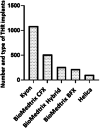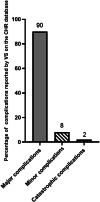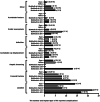Outcomes and complications reported from a multiuser canine hip replacement registry over a 10-year period
- PMID: 36062338
- PMCID: PMC10087566
- DOI: 10.1111/vsu.13885
Outcomes and complications reported from a multiuser canine hip replacement registry over a 10-year period
Abstract
Objective: To report outcomes and complications associated with total hip replacements (THR) using a multiuser canine hip registry (CHR) and owner-administered questionnaire.
Study design: Prospective longitudinal clinical study.
Animals: Dogs (n = 1852).
Methods: Total hip replacement cases submitted to a CHR were reviewed. An online questionnaire including an adapted "Liverpool Osteoarthritis in Dogs" (LOAD) score was e-mailed to owners. Data were analyzed to determine associations between clinical variables and the agreement by veterinary surgeons and owners for complications.
Results: A group of 1329 (72%) dogs had unilateral THRs and another group of 523 (28%) dogs had bilateral THRs, resulting in 2375 THRs. Indications included hip dysplasia and osteoarthritis (n = 2028/2375, 85%). Implants were manufactured by Kyon (n = 1087, 46%), BioMedtrix CFX (n = 514, 22%), BioMedtrix hybrid (n = 264, 11%), BioMedtrix BFX (n = 221, 9%), and Helica (n = 107, 4.5%). Median veterinary surgeon and owner follow up were 1328 and 900 days respectively. Postoperative LOAD scores (21 ± 9) reported by 461 owners improved compared to preoperative scores (11 ± 9) (P < .001). Veterinary surgeons reported complications in 201/2375 (8.5%) THRs and owners in 107/461 (23%) THRs, with moderate agreement (weighted kappa = 0.44). No associations were identified between complications and weight, age, sex, or breed. BioMedtrix BFX and Helica implants were associated with increased complications (P = .031) when used for revisions of femoral head and neck excisions.
Conclusion: Excellent outcomes, including improved canine mobility, were reported after THRs. Complications were underreported by veterinary surgeons compared to owners in this first multiuser CHR.
Clinical significance: Canine THRs are safe, effective procedures but THR implants should be carefully selected when revising femoral head and neck excisions.
© 2022 The Authors. Veterinary Surgery published by Wiley Periodicals LLC on behalf of American College of Veterinary Surgeons.
Conflict of interest statement
The authors declare no conflict of interest related to this report.
Figures












Similar articles
-
Evaluation of variables influencing success and complication rates in canine total hip replacement: results from the British Veterinary Orthopaedic Association Canine Hip Registry (collation of data: 2010-2012).Vet Rec. 2017 Jul 1;181(1):18. doi: 10.1136/vr.104036. Epub 2017 Apr 6. Vet Rec. 2017. PMID: 28386028
-
Complications and owner assessment of canine total hip replacement: a multicenter internet based survey.Vet Surg. 2012 Jul;41(5):545-50. doi: 10.1111/j.1532-950X.2012.01015.x. Epub 2012 Jun 25. Vet Surg. 2012. PMID: 22731937
-
Hybrid cemented/cementless total hip replacement in dogs: seventy-eight consecutive joint replacements.Vet Surg. 2011 Jul;40(5):621-30. doi: 10.1111/j.1532-950X.2011.00827.x. Epub 2011 Apr 26. Vet Surg. 2011. PMID: 21521239 Clinical Trial.
-
BioMedtrix Total Hip Replacement Systems: An Overview.Vet Clin North Am Small Anim Pract. 2017 Jul;47(4):899-916. doi: 10.1016/j.cvsm.2017.03.005. Vet Clin North Am Small Anim Pract. 2017. PMID: 28576274 Review.
-
Zurich Cementless Dual Mobility Cup for Canine Total Hip Prosthesis: Implant Characteristics and Surgical Outcome in 105 Cases.Vet Comp Orthop Traumatol. 2021 Jul;34(4):294-302. doi: 10.1055/s-0041-1725015. Epub 2021 Mar 31. Vet Comp Orthop Traumatol. 2021. PMID: 33792006 Review.
Cited by
-
Outcome One Year after Acetabular Rim Extension Using a Customized Titanium Implant for Treating Hip Dysplasia in Dogs.Animals (Basel). 2024 Aug 17;14(16):2385. doi: 10.3390/ani14162385. Animals (Basel). 2024. PMID: 39199919 Free PMC article.
-
Long term outcomes of the Humeral Intracondylar Repair System for management of canine humeral intracondylar fissures and humeral condylar fractures.Front Vet Sci. 2024 Jan 3;10:1296940. doi: 10.3389/fvets.2023.1296940. eCollection 2023. Front Vet Sci. 2024. PMID: 38234987 Free PMC article.
-
Multiple Intra-Articular Injections of Adipose-Derived Mesenchymal Stem Cells for Canine Osteoarthritis Treatment.Cells. 2025 Feb 20;14(5):323. doi: 10.3390/cells14050323. Cells. 2025. PMID: 40072052 Free PMC article.
-
COAST Development Group's international consensus guidelines for the treatment of canine osteoarthritis.Front Vet Sci. 2023 Aug 3;10:1137888. doi: 10.3389/fvets.2023.1137888. eCollection 2023. Front Vet Sci. 2023. PMID: 37601753 Free PMC article. Review.
-
Medium-term outcomes of hybrid total hip arthroplasty in cats: Cemented femoral stem and cementless acetabular cup in 17 hips (2020-2023).Vet Surg. 2025 Aug;54(6):1122-1132. doi: 10.1111/vsu.14274. Epub 2025 Jun 5. Vet Surg. 2025. PMID: 40474443 Free PMC article.
References
-
- Olmstead ML, Hohn RB, Turner TM. A five‐year study of 221 total hip replacements in the dog. J Am Vet Med Assoc. 1983;183:191‐194. - PubMed
-
- Chang RW, Pellisier JM, Hazen GB. A cost‐effectiveness analysis of total hip arthroplasty for osteoarthritis of the hip. JAMA. 1996;275:858‐865. - PubMed
-
- Cook JL, Evans R, Conzemius MG, et al. Proposed definitions and criteria for reporting time frame, outcome, and complications for clinical orthopedic studies in veterinary medicine. Vet Surg. 2010;39:905‐908. - PubMed
-
- Massat BJ, Vasseur PB. Clinical and radiographic results of total hip arthroplasty in dogs: 96 cases (1986–1992). J Am Vet Med Assoc. 1994;205:448‐454. - PubMed
-
- Marcellin‐Little DJ, DeYoung BA, Doyens DH, DeYoung DJ. Canine uncementless porous‐coated anatomic total hip arthroplasty: results of a long‐term prospective evaluation of 50 consecutive cases. Vet Surg. 1999;28:10‐20. - PubMed
MeSH terms
Grants and funding
LinkOut - more resources
Full Text Sources
Medical

